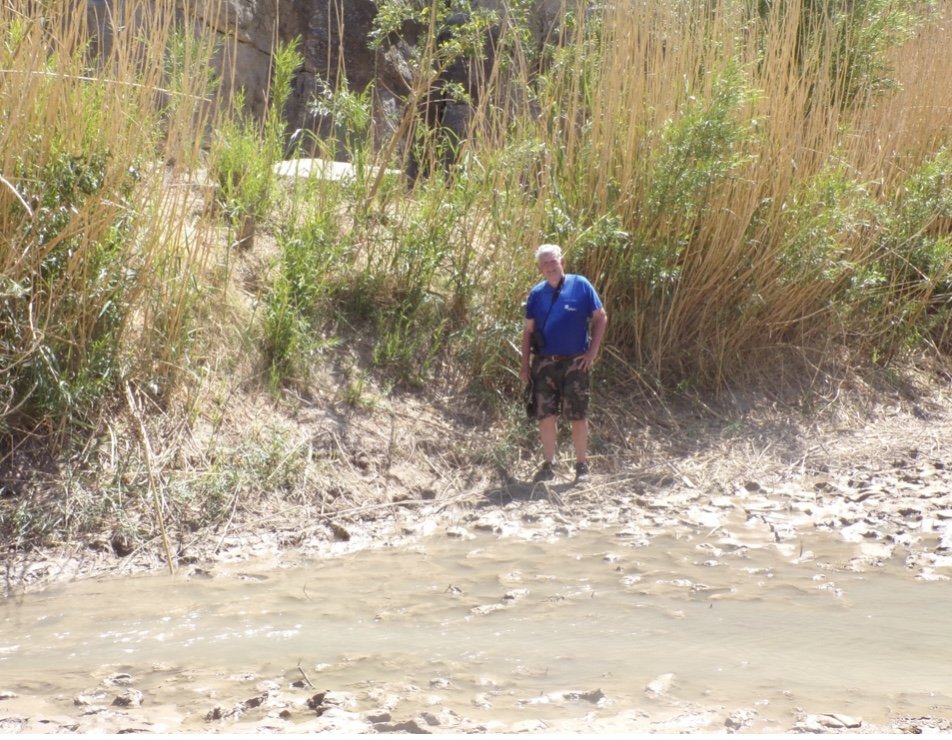[ad_1]
[Editor’s note: Hot Springs resident, birder and Democrat-Gazette freelancer Jerry Butler decided to take his ornithology hobby just a bit south of the border as an “illegal alien.” Here is his account of his adventure.]
In April, at the age of 80, I finally made a bucket-list trip with my friend Gary Hickerson, a retired microbiologist from Searcy, out west to look at birds. We were two old geezers, living out a dream that we’d had for decades. In the course of that trip, we camped out in Big Bend National Park along the banks of the Rio Grande.
It was unseasonably hot, and one day the temperature reached 106 degrees. We stayed cool only by looking for birds while standing in the shade of trees when possible, birding in the early morning and late evening, and by wearing broad-brimmed hats while in the intense sun.
Nights cool off swiftly in desert-like conditions. If you keep the flap of the tent open, it’s really quite comfortable after dark, and a light blanket feels good in the wee hours of the morning.
On our third day at Big Bend, in the heat of midday, we drove to the far west end of the park to find Santa Elena Canyon. There, the Rio Grande has cut a deep canyon through the Guadalupe Mountains in the past millennia. We were there in search of the elusive canyon wren. At that point the Rio Grande is actually not very “grande”; it’s just a narrow creek. In my younger days I could have jumped across the stream flat-footed. Beavers had started building a dam between the canyon bluff on the Mexican side and the muddy bank on the U.S. side.
Wearing a pair of old tennis shoes, I had an opportunity to cool my feet by wading in the water and perhaps crossing the border. However, my passport has expired, and it was back home a thousand miles away. I determined that I would walk across that beaver dam anyway.
In spite of the impression you may have been given on the 10 o’clock news, there is no “wall” along that part of the border. There are no hordes of immigrants pushing to cross the southern border illegally. The U.S. Border Patrol’s presence, which I’d witnessed other places farther east, was absent there. There were no Federales on the Mexican side, either. So, I attempted to negotiate my steps across the top of the beaver dam by walking on felled narrow saplings, using the few rocks that were visible in the clear water as stepping-stones, and by balancing myself with a dried willow limb that extended above the rest of the beavers’ loosely organized dam.
Just as I was about to step into Mexico, the willow limb broke. I fell into the water on the downstream side, and I could get no solid footing on the slick bank. In falling, I lunged and placed my hand on Mexican soil, but the bulk of my body splashed and submerged into cool water.
 Having waded across the shallow Rio Grande, writer Jerry Butler stood in Mexico while his companion, Gary, took his picture from Texas. (Courtesy of Jerry Butler)
Having waded across the shallow Rio Grande, writer Jerry Butler stood in Mexico while his companion, Gary, took his picture from Texas. (Courtesy of Jerry Butler)
I was not hurt. My head did not go under, but most of my clothes were wet and muddy.
I was not worried about that so much as I was concerned about my binoculars. The Nikon “binocs,” which I constantly wear when on such expeditions, dipped beneath the surface of the water and took on moisture that caused them to instantly fog up. I checked them immediately, only to discover that they were useless for birdwatching without serious attention. A similar thing had happened to me before.
Having barely reached Mexico to the east of the dam, I picked myself up and tried to enter into a more westerly Mexico by walking across the mud flats upstream of the beaver dam. There, the water was only slightly above my shoe tops and I waded across easily.
Finally I stood, firmly planted in Mexico as an unauthorized alien. My friend Hickerson, who is a wimp for such adventures, took my picture. He was still standing in the good ol’ U S of A.
When I waded back to American soil, we climbed part way up the steep, 1,500-foot canyon wall on our right, then walked on the canyon floor. We saw few birds, only a solitary soaring Swainson’s hawk and a few unidentifiable swallows. We never found the canyon wren, neither there or at any other stop along our two-week trip into New Mexico and Arizona. I made do with a spare pair of binoculars until the heat and low humidity of that area could withdraw the moisture from my regular pair.
My clothes dried quickly in the desert air. Even with the sweat and exertion of ascending and descending the tall canyon wall, by the time we got back to my friend’s car, my shirt and trousers were as dry as if they had hung on the line all day. But my birding pal would not let me sit in his car’s passenger seat for fear that I would soil his upholstery, so I changed my clothes.
Then we went on our way, looking for a Gamble’s quail, a violet-crowned hummingbird or an elegant trogon — all of which we did eventually find without ever again leaving “the land of the free and the home of the brave.”
[ad_2]
Source link













